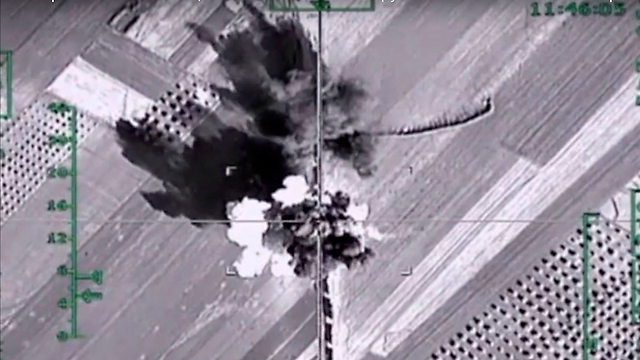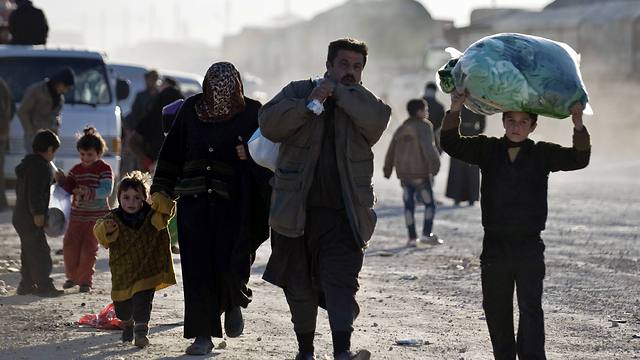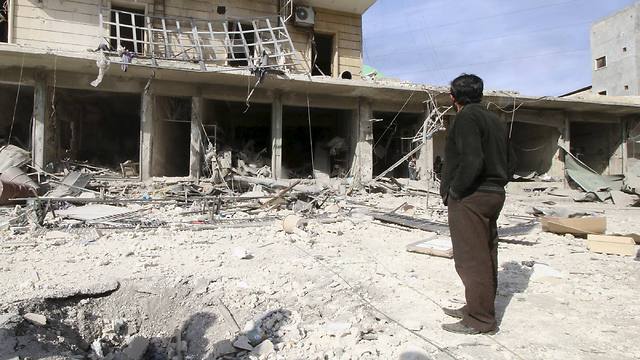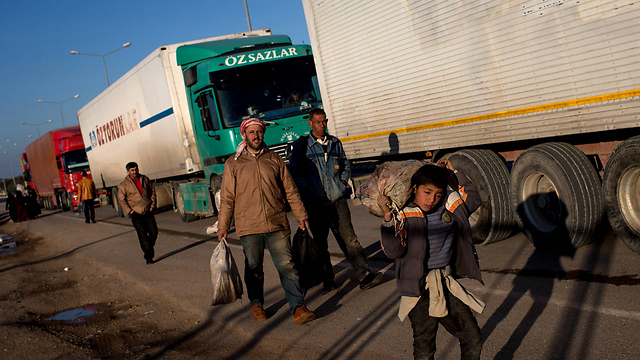Analysis:Russia's new strategy to prop Assad up is to destroy rebels' power base through ethnic cleansing, forcing supporters to flee as refugees to neighboring countries and eventually Europe.
Russian forces, combined with the Iranians and Hezbollah, have changed their tactics in Syria. With a complete disregard to the international community, they are intensively bombing rebel bases, even at the risk of killing thousands of civilians, and starting a new wave of refugees. The two major focus points in the campaign are the cities of Aleppo and Deraa.
It is becoming apparent that a turning point in the favor of the Assad regime, Hezbollah, and the Iranians has occurred in the Syrian Civil War and they have only Vladimir Putin to thank. More specifically – for his vicious yet effective strategy and the generals he has loaned to the regime in order to direct the campaign against the Sunni rebels.
However, what is happening in practice is ethnic cleansing and a new wave of refugees leaving Syria.

Photo: AP
Until the arrival of the Russians, the Syrian regime, with the assistance of Hezbollah and the Iranians, fought the rebels by attempting to destroy them piecemeal. These sporadic military operations happened here and there and were fought with little to no overarching goal, except to keep rebels away from places of economic or moral importance, and to stop the capture of military bases and government facilities.
There was also a special, almost sacred effort to stop the massacre of Alawites and Shiites, which the Islamists carried out with glee any time the chance arose. Only occasionally was there a clear military objective with a clear strategic purpose.
This lack of strategy very nearly led to the fall of the Assad regime in the spring of 2015. It was then that the Russians entered the fray - not due to any particular love for the Assad regime or the Iranians, but to protect and defend the strategic interests and assets they had in the country.
Yet, the Russians did not have much success at the beginning of their efforts in Syria. This is because the original method employed by the Russians was a copy of the unsuccessful strategy used by the US-led coalition in Libya, Syria, and Iraq, and against ISIS. The American strategy was based on precision airstrikes, while ground forces would be comprised of local forces- such as the Iraqi army and the Kurdish Peshmerga.
The Russians and the Iranians began their joint operations in Syria in order to eliminate the threat posed by the rebels to the Shiite and the Alawite heartland, specifically the port cities of Latakia and Tartus, cities which also house the principal Russian military installations in Syria.

Photo: AP
The ground forces operating beneath the Russian air umbrella were members of the Iranian Revolutionary Guards, Basij militias, and additional Shiite militias from Iraq and Afghanistan. However, this combined Russian-Iranian-Syrian-Hezbollah offensive stalled within three months. While the immediate threat to the city of Latakia was pushed back, further gains were not made.
The Russian generals quickly realized after these three months that their strategy was not working. They understood that the secret weapon of the rebel groups they were fighting lay in the fact that the rebels can melt into the civilian population at will, and that the local Sunni community supports and assists them. And it wasn't as if the Russians were avoiding hitting targets in the middle of crowded Sunni cities and towns. They didn't even take civilian casualties into consideration.
But it seems that the Russians indeed understood this secret weapon - the close ties between the rebel fighters and the communities within which they were fighting. The rebels could go on the offensive from hidden areas within the village, then return and blend in with the civilian population when the response came. This was a classic guerrilla war which the rebels were able to fight for an unlimited amount of time.
To top it all off, these fighters are people who were born and raised in these villages, and the civilian population provided them with everything they needed - moral support, food from UN aid convoys, medical attention, hiding places, and firing positions from within private houses and schools.
On top of this, the assimilation of the rebels into the population of non-combatants triggered international condemnation of airstrikes on these rebel positions. The Russians had to start planning their strikes with additional auction. In short, all the tactics that the IDF has dealt with in its wars against Hezbollah in Lebanon and Hamas in Gaza were working marvelously for the rebels in Syria. Therefore, the Russian generals, who had learned from the Russian experiences in Chechnya, Afghanistan, and now Syria, decided to take off their gloves and brush off all criticism coming from the international community.
They understood that to bring about a turning point, they would have to denigrate the fighting capabilities of the Syrian guerillas, and that they would have to separate the rebels from their two principal power bases: support by the civilian population and outside military assistance received via Turkey, Jordan, and Lebanon.
The new strategy the Russians formulated was to destroy these power bases through ethnic cleansing, and force them to flee as refugees to Turkey, Jordan, and Lebanon, and from there on to Europe. As a complementary measure, they would subject those who stayed to blockades and sieges, starving those who refused to leave.
And therefore, according to credible western sources, the "Russian System" has been activated in Syria. First; they determine senior commanders in the Russian-Iranian-Hezbollah coalition who are from communities which are under rebel occupation, and base them and consolidate these forces who are loyal and essential to the Assad regime. The Russians will then start an intensive bombing campaign of these cities, day and night, with no effort to differentiate between combatant and civilian.
At the same time, the Syrian military, alongside Hezbollah and the Iranians, concentrate their forces on the ground. Infantry units then perform a survey of the area next to the bombed out town. Most of the civilians and rebels who had survived the bombings will have already run for their lives, or will have taken cover in the basements and cellars of the houses throughout the village. And even then, the Syrian military and its allies are in no rush to go into the town to capture it. They simply situate themselves at the entrances to the town, and set up a siege.
The rebels and civilians who survived the bombing can't escape or start over. They don't get any food, water, or anything else which would permit them to live. Between this, and the Russian bombs which continue to fall on them, they are faced with two equally bad options: to either die of hunger or the bombs, or surrender and be killed on the spot.
By contrast, the tactics during the beginning of the civil war were much different: the Syrian forces would enter the towns from which the rebels fled, imbued with a sense of victory, while the civilians (who were also supporters of the rebels) continued to live in the towns. The area would then stay under the control of Hezbollah or the regime until the rebels were able to regroup and be re-armed by the Americans or the Saudis, and then, with the help of the civilians, would come in and retake the city. And the cycle would continue.

Photo: Reuters
Just the knowledge of the brutal Russian and Iranian strategy - the indiscriminate carpet bombings, the merciless sieges, and the cutting off of supply routes - has sent a tsunami of people, rushing towards the border. Non-combatants and rebels both are fleeing for their lives to the border in their thousands before it is too late. They are worried that the Iranian, Syrian, and Hezbollah ground forces will cut off the escape routes to Turkish and Jordanian borders, and that they will find themselves hungry and under siege, dependent on the grace of a Syrian government which knows no mercy.
A sensitive situation on the Golan Heights
The Russian-Iranian-Hezbollah coalition is currently using this new strategy on two fronts: Aleppo and Deraa.Deraa, the less important of the two fronts, is situated in southern Syria, close to the border with Jordan. The revolution was started here five years ago by Sunni tribesmen angry at the regime. This city is of moral and symbolic importance, and its capture would deal a harsh blow to the rebels' morale. It will also make it more difficult for the rebels to receive assistance from Jordan, as that border would be cut off. Finally, the fall of Deraa would deal a harsh blow to the Nusra Front, as it main headquarters are located there.
In addition, Deraa is only 25 miles from the border fence on the Golan Heights. Therefore, whatever happens in Deraa will have an indirect effect on Israel. If the Assad regime is able to capture the city, the next step may be to open up an offensive to recapture the Syrian Golan, with the help of Hezbollah and the Iranians, and plenty of Russian air support. This is not an ideal situation for Israel. It will require Russian jets to operate dangerously close to the Israeli border, and will test the coordination between the IDF and the Russian air force.
If the Russian-Syrian collation is able to conquer the Syrian Golan heights, it will be easier for the Iranians and Hezbollah to open up another front for terrorist acts against Israel. It is likely that the Russians would not stop Hezbollah and the Iranians, so long as their actions don't lead to another war.
However, the principal offensive of the Russian-Shiite coalition is taking place in Aleppo in northern Syria. It is the second largest city in the county, but is the most important city strategically, economically, and culturally. It is considered the most important city which is not under complete government control. The Free Syrian Army, Islamist groups such as the Nusra Front, Army of Islam, and Ahrar a-Sham, are all in control of different parts of the city. ISIS even maintains a small presence within Aleppo, but controls large swathes of territory to the east and north of the city.

Photo: Getty Images
The capture of Aleppo may determine the fate of the fight for the rest of northern Syria, and represent another major turning point for the embattled Assad regime. A victory here has the ability to cut the off the Sunni rebels' access to the border with Turkey, and trap them between the Syrian regime in the south, the Kurdish forces in the north, and ISIS in the east.
There are people in Washington and London who believe that if only they could get stinger anti-aircraft missiles into the hands of the rebels, the will be able to defend themselves in the face of Russian airstrikes. Happy is the believer. The Russians are not impressed and are in no rush. Their Sukhoi-30 jets continue to pound cities and agricultural towns around Aleppo from the air, and even hit targets within the city itself. Meanwhile, Syrian, Iranian, and Hezbollah forces are happy on the ground, and are capturing town after town.
It seems that the Russian and Iranian generals intend to bomb Aleppo to smithereens, and then put up a siege around the city. The Iranian, Syrian, and Hezbollah militants are not in any hurry to enter the city for street to street fighting. Instead, they will wait until the starved city surrenders and falls into their hands like dried fruit. The coalition has already closed off one of the central highways connecting Aleppo with the Turkish border. All that remains is one narrow corridor which is soon to be closed off as well. Tens of thousands have already begun to gather at the border crossing next to the Turkish town of Kilis yet the Turkish government only permits an infinitesimal number of them - the heavily wounded and desperately ill- to cross into its territory.
Erdogan has issued strong condemnations against Russian brutality, but has also exploited the humanitarian crisis to try to convince the Americans and Russians to establish a “safe zone” for refugees in Syrian territory, along the southern Turkish border. The Turkish President has advocated for this option because he does not want more refugees to enter Turkey. Meanwhile Chancellor Angela Merkel is pressuring Erdogan to accept more refugees and allow them to stay in Turkish territory.
Erdogan wants to pressure the Americans to create a no-fly zone along the Turkish-Syrian border to protect the refugees and the Turkmen minority, rebelling against Assad. However, these efforts are in vain. Washington has decided that the war against ISIS is more important than removing Assad. Thus, it does not want to confront the Russians and its proxies and instead is cooperating with it.
President Obama wants to resolve the crisis through diplomatic means with the Russians as it did with the chemical weapons issue in 2013. Thus, Obama is turning his back on the cries of Syrian citizens and rebels fleeing for their lives, as well as their Saudi and Turkish backers..
Meanwhile, the largest ethnic cleansing in history since World War II continues: eight million Syrians- one third of the entire Syrian population- are already refugees either in Syria or in other countries. If that is not ethnic cleansing- then there simply is no longer any meaning to the phrase. The number of dead has long since passed 300,000 and it seems that the number of wounded is closing in on a million. Year after year the UN passes resolutions alleging that the Syrian government's actions border on crimes against humanity. Meanwhile, Obama, the UK, and the EU stand on the sidelines, silently hoping that the Russians will be able to avert a humanitarian crisis.
The Russian foreign minister stood up to the West and presented two a simple option to them: permit Aleppo and its residents to bleed and starve to death – or the West, the Gulf countries, and Turkey will force the rebel groups to accept the Russian peace plan. This plan, which was drawn up by the Kremlin, and in consultation with the Americans, will permit Assad to continue to rule for another year and a half until the next round of Syrian general elections, and then step down in peace.
The supposedly new regime that will be formed in Syria will be comprised of Assad loyalists and will maintain the interests of the Shiites, Russians, and Iranians.
The rebels have rejected Russian, British and Saudi peace plans. They demand that Assad be thrown out of power as soon as the peace process begins, not when it ends. However, United Nations Envoy to Syria Staffan de Mistura suggests first declaring a partial or full ceasefire, then providing humanitarian supplies for besieged and starving towns – and only then discussing specific details.

No comments:
Post a Comment